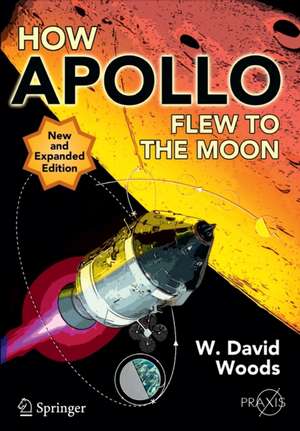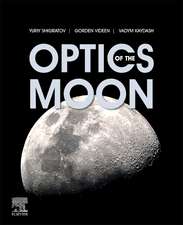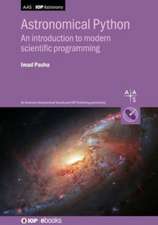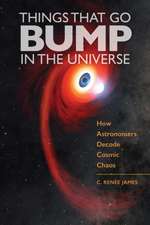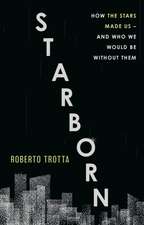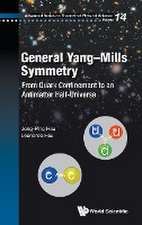How Apollo Flew to the Moon: Springer Praxis Books
Autor W. David Woodsen Limba Engleză Paperback – 8 aug 2011
Din seria Springer Praxis Books
-
 Preț: 294.46 lei
Preț: 294.46 lei -
 Preț: 223.45 lei
Preț: 223.45 lei -
 Preț: 193.12 lei
Preț: 193.12 lei -
 Preț: 167.85 lei
Preț: 167.85 lei -
 Preț: 288.98 lei
Preț: 288.98 lei -
 Preț: 323.74 lei
Preț: 323.74 lei -
 Preț: 401.38 lei
Preț: 401.38 lei -
 Preț: 264.12 lei
Preț: 264.12 lei - 8%
 Preț: 513.00 lei
Preț: 513.00 lei -
 Preț: 190.01 lei
Preț: 190.01 lei -
 Preț: 218.16 lei
Preț: 218.16 lei -
 Preț: 312.06 lei
Preț: 312.06 lei - 17%
 Preț: 414.04 lei
Preț: 414.04 lei -
 Preț: 216.41 lei
Preț: 216.41 lei -
 Preț: 262.27 lei
Preț: 262.27 lei -
 Preț: 264.35 lei
Preț: 264.35 lei -
 Preț: 167.63 lei
Preț: 167.63 lei -
 Preț: 284.81 lei
Preț: 284.81 lei -
 Preț: 259.08 lei
Preț: 259.08 lei -
 Preț: 305.47 lei
Preț: 305.47 lei -
 Preț: 244.14 lei
Preț: 244.14 lei -
 Preț: 227.85 lei
Preț: 227.85 lei -
 Preț: 285.25 lei
Preț: 285.25 lei -
 Preț: 295.56 lei
Preț: 295.56 lei -
 Preț: 357.17 lei
Preț: 357.17 lei -
 Preț: 275.79 lei
Preț: 275.79 lei -
 Preț: 257.08 lei
Preț: 257.08 lei -
 Preț: 349.71 lei
Preț: 349.71 lei -
 Preț: 272.45 lei
Preț: 272.45 lei -
 Preț: 270.27 lei
Preț: 270.27 lei - 8%
 Preț: 456.51 lei
Preț: 456.51 lei -
 Preț: 352.34 lei
Preț: 352.34 lei - 8%
 Preț: 394.80 lei
Preț: 394.80 lei -
 Preț: 320.65 lei
Preț: 320.65 lei -
 Preț: 325.29 lei
Preț: 325.29 lei -
 Preț: 253.11 lei
Preț: 253.11 lei -
 Preț: 192.86 lei
Preț: 192.86 lei -
 Preț: 313.40 lei
Preț: 313.40 lei -
 Preț: 150.51 lei
Preț: 150.51 lei -
 Preț: 233.34 lei
Preț: 233.34 lei -
 Preț: 286.78 lei
Preț: 286.78 lei -
 Preț: 212.01 lei
Preț: 212.01 lei -
 Preț: 366.83 lei
Preț: 366.83 lei -
 Preț: 299.99 lei
Preț: 299.99 lei -
 Preț: 232.27 lei
Preț: 232.27 lei -
 Preț: 284.58 lei
Preț: 284.58 lei -
 Preț: 212.45 lei
Preț: 212.45 lei -
 Preț: 159.81 lei
Preț: 159.81 lei -
 Preț: 349.48 lei
Preț: 349.48 lei - 20%
 Preț: 2061.61 lei
Preț: 2061.61 lei
Preț: 356.07 lei
Nou
Puncte Express: 534
Preț estimativ în valută:
68.13€ • 71.14$ • 56.39£
68.13€ • 71.14$ • 56.39£
Carte disponibilă
Livrare economică 14-28 martie
Livrare express 27 februarie-05 martie pentru 67.76 lei
Preluare comenzi: 021 569.72.76
Specificații
ISBN-13: 9781441971784
ISBN-10: 1441971785
Pagini: 456
Ilustrații: XXXI, 555 p. 255 illus., 127 illus. in color.
Dimensiuni: 170 x 244 x 35 mm
Greutate: 0.98 kg
Ediția:2nd ed. 2011
Editura: Springer
Colecția Springer
Seriile Springer Praxis Books, Space Exploration
Locul publicării:New York, NY, United States
ISBN-10: 1441971785
Pagini: 456
Ilustrații: XXXI, 555 p. 255 illus., 127 illus. in color.
Dimensiuni: 170 x 244 x 35 mm
Greutate: 0.98 kg
Ediția:2nd ed. 2011
Editura: Springer
Colecția Springer
Seriile Springer Praxis Books, Space Exploration
Locul publicării:New York, NY, United States
Public țintă
Popular/generalCuprins
Illustrations.- Author's Preface.- Acknowledgements.- Foreword.- Chapter 1: Apollo - an extraordinary adventure.- Chapter 2: The Apollo Flights - a brief history.- Chapter 3: Launch - a fiery departure.- Chapter 4: Earth orbit and TLI.- Chapter 5: Retrieving the lander.- Chapter 6: Navigating to the Moon.- Chapter 7: Coasting to the Moon.- Chapter 8: Entering lunar orbit - the LOI manoeuvre.- Chapter 9: Preparation for landing.- Chapter 10: Next stop - the Moon.- Chapter 11: Down in the dust.- Chapter 12: Exploration at its greatest.- Chapter 13: Rendezvous and docking.- Chapter 14: Heading for home.- Chapter 15: Re-entry.- Epilogue.- Glossary.- Appendix 1: Computer programs.- Appendix 2: Mission data.- Further reading.- Index.
Recenzii
From the reviews of the second edition:
“This book was written for those … to learn without the prerequisite degree in aeronautics. … Due to the high level of detail that is paid to virtually all aspects of Apollo, this book is well worth the price and should be considered a must have for space aficionados. … There are additional stories of Apollo’s engineering triumphs both on the surface of the Moon as well as in flight, much of which reflects my continuing journey into the technical achievement that was Apollo.” (Jason Rhian, Aviation Week, March, 2011)
“How Apollo Flew to the Moon is the consummate technical narrative about the Apollo lunar program for the nontechnical reader. … for those who have a long-held interest in the Apollo program and always wondered how things worked this is a treasure trove. … is not only a fun and accessible tech-read but also a very valuable reference book, where you will find detail and minutia that is difficult to find anywhere else. … no comparable work which is so accessible or rewarding to read.” (Rod Pyle, Quest, Vol. 19 (3), 2012)
“This book was written for those … to learn without the prerequisite degree in aeronautics. … Due to the high level of detail that is paid to virtually all aspects of Apollo, this book is well worth the price and should be considered a must have for space aficionados. … There are additional stories of Apollo’s engineering triumphs both on the surface of the Moon as well as in flight, much of which reflects my continuing journey into the technical achievement that was Apollo.” (Jason Rhian, Aviation Week, March, 2011)
“How Apollo Flew to the Moon is the consummate technical narrative about the Apollo lunar program for the nontechnical reader. … for those who have a long-held interest in the Apollo program and always wondered how things worked this is a treasure trove. … is not only a fun and accessible tech-read but also a very valuable reference book, where you will find detail and minutia that is difficult to find anywhere else. … no comparable work which is so accessible or rewarding to read.” (Rod Pyle, Quest, Vol. 19 (3), 2012)
Notă biografică
In his spare time, W. David Woods, took up studying the Apollo program and contributing to its documentation on the web. In 1994, he began scanning NASA history books under the aegis of the NASA History Division for presentation on the web. In 1997, David was presented with a Public Service Award in Washington D.C. by the NASA Administrator. In 1998, David began publishing the Apollo Flight Journal online, hosted by NASA. again under the aegis of the NASA History Division. This project is a companion to the highly regarded Apollo Lunar Surface Journal and both are considered canonical references about the Apollo missions. An AFJ consists of a core transcript of a mission. This is carefully corrected, commentary is added and is used as a structure upon which many multimedia types relevant to the mission can be hung. This includes audio, video, and photography from NASA's archives. The knowledge and experience gained while researching and writing for the AFJ led to the publication in 2008 of "How Apollo Flew to the Moon." This book has been very well received and reviewed. Many commentators place it within the top few books about the Apollo flights.
Textul de pe ultima copertă
This new and expanded edition of the bestselling How Apollo Flew to the Moon tells the exciting story of how the Apollo missions were conducted and follows a virtual flight to the Moon and back. New material includes:
- the exploration of the lunar surface;
- more illustrations;
- more technical explanations and anecdotes.
From launch to splashdown, hitch a ride in the incredible Apollo spaceships, the most sophisticated machines of their time. Explore each step of the journey and glimpse the enormous range of disciplines, techniques, and procedures the Apollo crews had to master. Although the tremendous technological accomplishments are well documented, the human dimension is not forgotten, and the book calls on the testimony of the people who were there at the time. A wealth of fascinating and accessible material is provided, including: the role of the powerful Saturn V; the reasoning behind trajectories; the day-to-day concerns of human and spacecraft health; the triumphs and difficulties of working in an unforgiving and hostile environment while surrounded by hard vacuum and pernicious dust; and the sheer daring that was involved in traveling to the Moon in the mid-20th century.
- the exploration of the lunar surface;
- more illustrations;
- more technical explanations and anecdotes.
From launch to splashdown, hitch a ride in the incredible Apollo spaceships, the most sophisticated machines of their time. Explore each step of the journey and glimpse the enormous range of disciplines, techniques, and procedures the Apollo crews had to master. Although the tremendous technological accomplishments are well documented, the human dimension is not forgotten, and the book calls on the testimony of the people who were there at the time. A wealth of fascinating and accessible material is provided, including: the role of the powerful Saturn V; the reasoning behind trajectories; the day-to-day concerns of human and spacecraft health; the triumphs and difficulties of working in an unforgiving and hostile environment while surrounded by hard vacuum and pernicious dust; and the sheer daring that was involved in traveling to the Moon in the mid-20th century.
Caracteristici
Uniquely provides in book form the complete story of the technology and techniques used to fly to the Moon and explore its surface Explains the flight controller and Apollo spacecraft crew roles in making the journey to the Moon possible and ensuring a safe return Looks at the technical way in which the journey to the Moon was achieved, but written in an accessible way to appeal to non-technical space enthusiasts Includes supplementary material: sn.pub/extras
